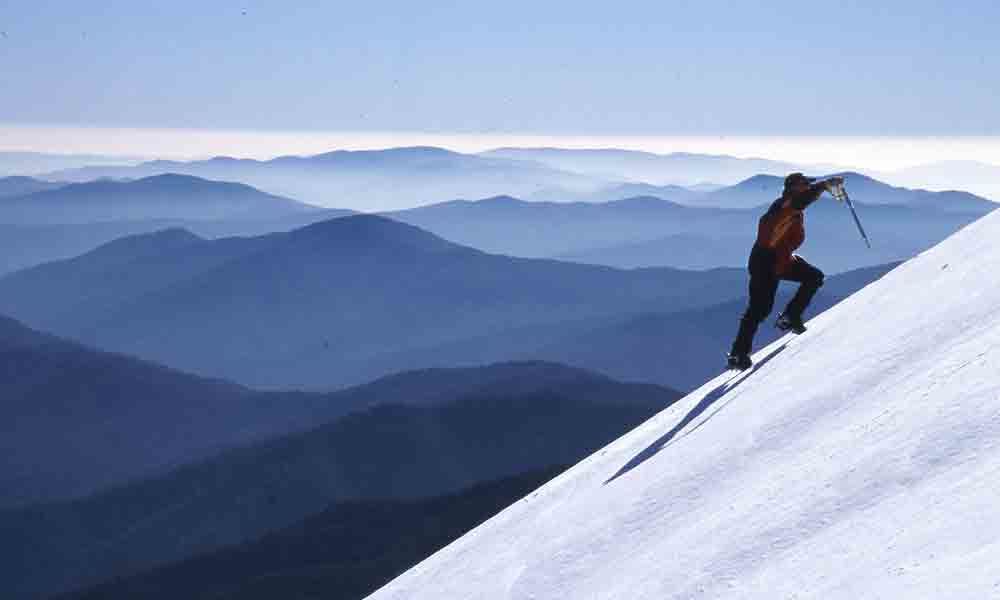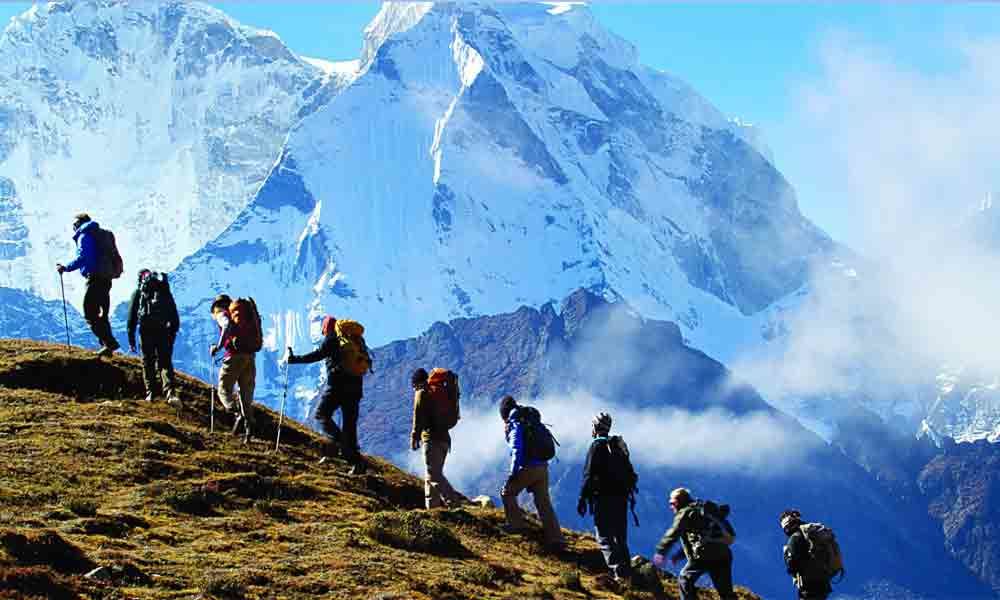Live
- Vijayawada: Inter-district offender nabbed, Rs 26 lakh loot seized
- Congress cancels all programmes for 7 days in honour of Dr. Manmohan Singh
- Nara Lokesh Pays Tribute to Manmohan Singh, says he is a visionary leader
- 6th World Telugu Writers meet from Dec 28
- Sri City role in strengthening Atmanirbhar Bharat lauded
- PCC chief accuses PM of lying on Visakha steel
- Vaikunta Dwara Darshan: Only those with tokens, tickets to be allowed
- Bandi Sanjay visits aspirational block in Narayanpet
- YSRCP calls for statewide protests today
- Power Tariff Hike: Jagan’s protests nothing but hypocrisy says Minister
Just In
It was the mid of May. The plains of India were simmering in the intense heat, but at the Everest base Camp the temperature was still sub zero. Through the fluttering of colourful flags, the Sherpas had planted in reverence to the sacred mountain which they called Chomolungma (Mt Everest to the rest of the world), a lady in fluorescent mountaineering gear looked up at the summit and saw herself trudging up the icy terrain. She had trained for six years to make it to the top of Mount Everest.
Then a few days later, on May 23, 2019, she fulfilled her dream as finally made it to the top. But she never got a chance to celebrate her success with family and friends, for she never came down. She died not due to any accident on the mountain, but due to dehydration, exhaustion and tiredness after being caught in the jam of climbers during the descent.
Traffic Jam on the Everest? Sounds unbelievable, isn't it?
In the recent years there have been reports of overcrowding along the narrow path leading to the summit of the Everest, with some having to wait for even 10 hours to get to the peak.
"Mountains are beginning and the end of all-natural scenery," says the famous artist John Ruskin. The delight of climbing high peaks and mountains is a resplendent experience of a lifetime.
Mount Everest is the highest mountain in the world. Till the 19th century, many of these mountains were gods supposedly lived could not be touched. The Tibetans called the Everest "Chomolungma" or "Goddess Mother of the World." Nepali villages around the mountain also knew it as "The Mountain So High No Bird Can Fly over it." Even to Western explorers who did not worship these mountains, they were a place of metaphysical significance possessing the kind of beauty that strikes terror and awe in the heart of the beholder and automatically makes him bow to the higher powers.
In the aftermath of the First World War, as shattered countries tried to restore themselves, the conquest of the Himalayas became the new test of national character. Many of those who took part in expeditions over the next few years had fought in the war.
The Mount Everest Committee in England was formed by the Alpine Club and the Royal Geographical to finance the first reconnaissance of the peak in 1921. In 1928, the Himalayan Club was formed by senior British members of the colonial government. Both were bent on putting an Englishman on top of Mount Everest.And the race began.
Since it was first conquered by Hillary and Norgay, around 4000 people had stood on the summit of Mount Everest with nearly 300 people having died in the attempt to scale it. Till the 1970s, the Nepalese government gave permits to only 20 people per year to climb the famed peak — but today; this has risen to 380-plus. Also 380 permits don't mean just 380 people, as for every climber, one Sherpa will also be there — that means the number of people climbing the mountain will be minimum 760.
The craze to conquer Mount Everest and the other prestigious peaks of the Himalayas, and the glory which comes with it is tempting adventurers around the world. Mountaineering has today become a big money-making business. The attitude of mountaineers also has changed since the days of Tenzing Norgay. He was passionate for what he did. Now, anyone who has money can climb the Everest. People only want to register their names amongst those who have climbed Everest. Today, journeys up the mountain are so common that, before the start of every climbing season, expert Sherpa and mountaineers are sent up the slopes to set up "fixed lines", nylon ropes that demarcate the route climbers should take.
The Himalayas were scattered with tragedy this summer. Eleven climbers died on Mount Everest, many of them forced to wait for hours in the "death zone," due to "traffic jam" visuals of which flooded the media—a long queue of climbers clinging to a rope, waiting for their turn at the top.
The other tragedy occurred far from the public eye, in one of the last remote icy frontiers of the world. Eight climbers went missing on Uttarakhand's Nanda Devi, the highest peak in India. The group had permission to climb the Nanda Devi East peak. Days later, five bodies were spotted on an un-scaled peak nearby. The rescue operation to retrieve them is still going on.
With so many tragedies regularly happening on the high mountains, one question definitely cries for an answer: Why do they do it? Why do people regularly risk their lives to summit a mountain peak or scale sheer cliffs?
"Because it's there," George Mallory famously replied in 1923 when asked why he was trying to climb Mount Everest.
For hundreds of adventure-sport enthusiasts in India and around the world, climbing the mountain is still the grand project it was for explorers a century ago. However, commercialising the Himalayas takes a serious toll on fragile ecosystems which must not be dismissed. Every year tons of piles of garbage comprising of discarded trekking equipment, empty tinned cans and plastic bottles and even dead bodies are cleared from the Everest and other peaks ahead of the climbing season.
The modern-day conquerors of Everest are not always tourists or trophy seekers. Among those who made it to the summit were people without limbs who wanted to try to transcend the limitations of the body. For them, to climb the high peaks of the Himalayas is to willingly enter a zone where human character and endurance is tested.
"We can't explain why we do it. And we don't care whether or not, we are understood. We only know that in discomfort, in storm, in the beauty and grandeur of the mountains we have discovered something very much worthwhile," they say.
That perhaps sums it all.
Climbing a mountain
Climbing the high peaks of the Himalayas is an extremely risky expedition. Nevertheless, the mountains continue to draw large numbers of adventurers.
Who can climb?
Only those with required experience of mountaineering and good fitness levels must attempt such a feat. The mountaineers must be well aware of their own body's responses at high altitudes and must have expertise to judge challenging situations, including taking halts at appropriate places from time-to-time.
Experts say only those with four to five years' experience of trekking, including scaling a few peaks at heights over 7,000 metres, should attempt to climb the higher ones towering above 8000 ft. This is because even the fittest humans struggle at altitudes higher than 8,000 feet — the most common symptoms being fatigue, headaches, vomiting, and dizziness.
What equipment is needed?
The list of mandatory climbing gear includes different types of equipment, including headgear, goggles, various rappelling devices like harness, carabiner and descenders, mountain boots, crampons, ropes, ice-sacks, etc. Special clothing includes a down jacket, mountain boots, windproof thermal layers, mitten gloves, thermal socks, oxygen masks and sleeping bags.
Climbers also require at least five 4.5-kg oxygen cylinders, plus a spare. Each cylinder lasts 7-8 hours at normal usage rate.

© 2024 Hyderabad Media House Limited/The Hans India. All rights reserved. Powered by hocalwire.com










